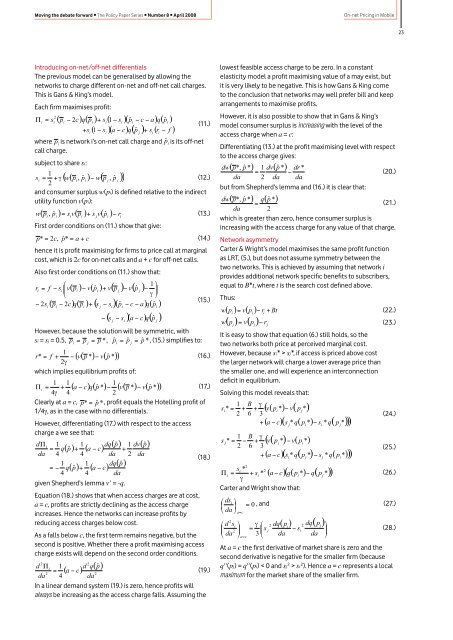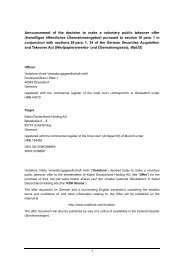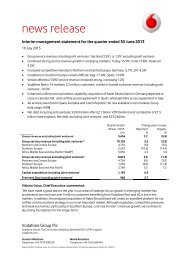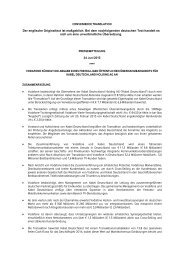Create successful ePaper yourself
Turn your PDF publications into a flip-book with our unique Google optimized e-Paper software.
Moving the debate forward • The Policy Paper Series • Number 8 • April 2008<br />
Introducing on-net/off-net differentials<br />
The previous model can be generalised by allowing the<br />
networks to charge different on-net and off-net call charges.<br />
This is Gans & King’s model.<br />
Each firm maximises profit:<br />
Π = s<br />
i<br />
2<br />
i<br />
( p − 2c)<br />
q(<br />
p ) + s ( 1 − s )( pˆ<br />
− c − a)<br />
q(<br />
pˆ<br />
)<br />
i<br />
+ s<br />
i<br />
i<br />
i<br />
( 1 − s )( a − c)<br />
q(<br />
pˆ<br />
) + s ( r − f )<br />
i<br />
where pi is network i’s on-net call charge and pˆ i is its off-net<br />
call charge.<br />
subject to share si:<br />
( w(<br />
p , pˆ<br />
) − w(<br />
p , p )<br />
i<br />
i<br />
j<br />
i<br />
i<br />
i<br />
(11.)<br />
1<br />
si = + γ i i<br />
j ˆ j<br />
(12.)<br />
2<br />
and consumer surplus w(pi) is defined relative to the indirect<br />
utility function v(pi):<br />
( pi<br />
pˆ<br />
i ) = siv(<br />
pi<br />
) + s jv(<br />
pˆ<br />
i ) ri<br />
w , −<br />
(13.)<br />
First order conditions on (11.) show that give:<br />
p * = 2c,<br />
pˆ<br />
* = a + c<br />
(14.)<br />
hence it is profit maximising for firms to price call at marginal<br />
cost, which is 2c for on-net calls and a + c for off-net calls.<br />
Also first order conditions on (11.) show that:<br />
⎛<br />
ri<br />
= f − si<br />
⎜v<br />
⎝<br />
− 2s<br />
i<br />
( p ) − v(<br />
pˆ<br />
) + v(<br />
p ) − v(<br />
pˆ<br />
)<br />
( p − 2c)<br />
q(<br />
p ) + ( s − s )( pˆ<br />
− c − a)<br />
q(<br />
pˆ<br />
)<br />
i<br />
i<br />
i<br />
i<br />
j<br />
−<br />
i<br />
( s − s )( a − c)<br />
q(<br />
pˆ<br />
)<br />
j<br />
j<br />
i<br />
i<br />
j<br />
1 ⎞<br />
− ⎟<br />
γ ⎠<br />
However, because the solution will be symmetric, with<br />
si = sj = 0.5, = p = p * , pˆ<br />
= pˆ<br />
= pˆ<br />
* , (15.) simplifies to:<br />
pi j<br />
i j<br />
1<br />
r* = f + − ( v(<br />
p * ) − v(<br />
pˆ<br />
* )<br />
2γ<br />
which implies equilibrium profits of:<br />
i<br />
j<br />
(15.)<br />
(16.)<br />
1 1<br />
1<br />
Π i = + ( a − c)<br />
q(<br />
pˆ<br />
* ) − ( v(<br />
p * ) − v(<br />
pˆ<br />
* )<br />
(17.)<br />
4γ<br />
4<br />
2<br />
Clearly at a = c, p * = pˆ<br />
* , profit equals the Hotelling profit of<br />
1/4γ, as in the case with no differentials.<br />
However, differentiating (17.) with respect to the access<br />
charge a we see that:<br />
( pˆ<br />
) 1 dv(<br />
pˆ<br />
)<br />
dΠ i 1 1 dq<br />
= q(<br />
pˆ<br />
) + ( a − c)<br />
+<br />
da 4 4 da 2<br />
1 1 dq<br />
( ) ( )<br />
( pˆ<br />
)<br />
= − q pˆ<br />
+ a − c<br />
4 4 da<br />
given Shepherd’s lemma v’ = -q.<br />
Equation (18.) shows that when access charges are at cost,<br />
a = c, profits are strictly declining as the access charge<br />
increases. Hence the networks can increase profits by<br />
reducing access charges below cost.<br />
As a falls below c, the first term remains negative, but the<br />
second is positive. Whether there a profit maximising access<br />
charge exists will depend on the second order conditions.<br />
( pˆ<br />
)<br />
da<br />
(18.)<br />
2<br />
2<br />
d Πi<br />
1 d q<br />
= ( a − c)<br />
(19.)<br />
2<br />
2<br />
da 4 da<br />
In a linear demand system (19.) is zero, hence profits will<br />
always be increasing as the access charge falls. Assuming the<br />
On-net Pricing in Mobile<br />
lowest feasible access charge to be zero. In a constant<br />
elasticity model a profit maximising value of a may exist, but<br />
it is very likely to be negative. This is how Gans & King come<br />
to the conclusion that networks may well prefer bill and keep<br />
arrangements to maximise profits.<br />
However, it is also possible to show that in Gans & King’s<br />
model consumer surplus is increasing with the level of the<br />
access charge when a = c:<br />
Differentiating (13.) at the profit maximising level with respect<br />
to the access charge gives:<br />
( p*,<br />
pˆ<br />
* ) 1 dv(<br />
pˆ<br />
* )<br />
dw<br />
da<br />
=<br />
2 da<br />
dr *<br />
−<br />
da<br />
(20.)<br />
but from Shepherd’s lemma and (16.) it is clear that:<br />
( p*,<br />
pˆ<br />
* ) q(<br />
pˆ<br />
* )<br />
dw<br />
= (21.)<br />
da 2<br />
which is greater than zero, hence consumer surplus is<br />
increasing with the access charge for any value of that charge.<br />
Network asymmetry<br />
Carter & Wright’s model maximises the same profit function<br />
as LRT, (5.), but does not assume symmetry between the<br />
two networks. This is achieved by assuming that network i<br />
provides additional network specific benefits to subscribers,<br />
equal to B*t, where t is the search cost defined above.<br />
Thus:<br />
( p ) v(<br />
p ) − r + Bt<br />
w i = i i<br />
(22.)<br />
w( pj)<br />
= v(<br />
pj)<br />
− rj<br />
(23.)<br />
It is easy to show that equation (6.) still holds, so the<br />
two networks both price at perceived marginal cost.<br />
However, because si* > sj*, if access is priced above cost<br />
the larger network will charge a lower average price than<br />
the smaller one, and will experience an interconnection<br />
deficit in equilibrium.<br />
Solving this model reveals that:<br />
1 B γ<br />
si*<br />
= + + ( v(<br />
pi<br />
* ) − v(<br />
p j*<br />
)<br />
2 6 3<br />
(24.)<br />
+ a − c s * q p * − s * q p *<br />
1 B γ<br />
s j*<br />
= − +<br />
2 6 3<br />
+<br />
( ) ( ( ) ( )<br />
j<br />
i<br />
( v(<br />
p j*<br />
) − v(<br />
pi*<br />
)<br />
( a − c)<br />
( s * q(<br />
p * ) − s * q(<br />
p * )<br />
i<br />
( a − c)<br />
( q(<br />
p * ) − q(<br />
p * )<br />
2<br />
si<br />
* 2<br />
Π i = + si<br />
*<br />
i<br />
γ<br />
Carter and Wright show that:<br />
⎛ dsi<br />
⎞<br />
⎜ ⎟<br />
⎝ da ⎠<br />
a=c<br />
2<br />
⎛ s ⎞ i ⎜ ⎟ 2<br />
⎝ da ⎠<br />
= 0<br />
j<br />
i<br />
j<br />
j<br />
j<br />
i<br />
(25.)<br />
(26.)<br />
, and (27.)<br />
γ ⎛<br />
= ⎜ s<br />
3 ⎝<br />
( p ) dq(<br />
p ) i 2 ⎞<br />
− s ⎟<br />
d 2 dq<br />
j<br />
a=<br />
c<br />
j<br />
da<br />
i<br />
da<br />
⎠<br />
(28.)<br />
At a = c the first derivative of market share is zero and the<br />
second derivative is negative for the smaller firm (because<br />
q''(pj) = q''(pi) < 0 and sj 2 > si 2 ). Hence a = c represents a local<br />
maximum for the market share of the smaller firm.<br />
23

















